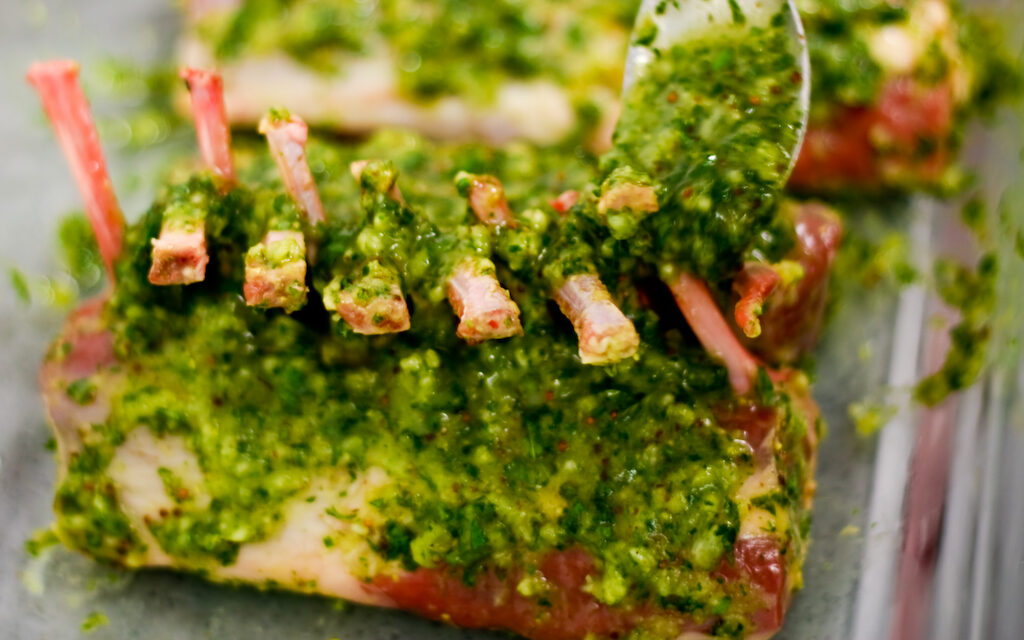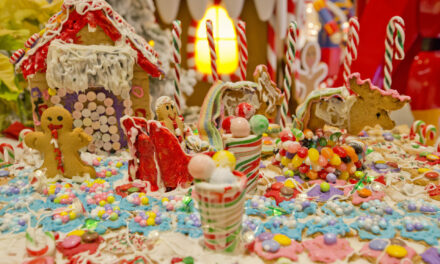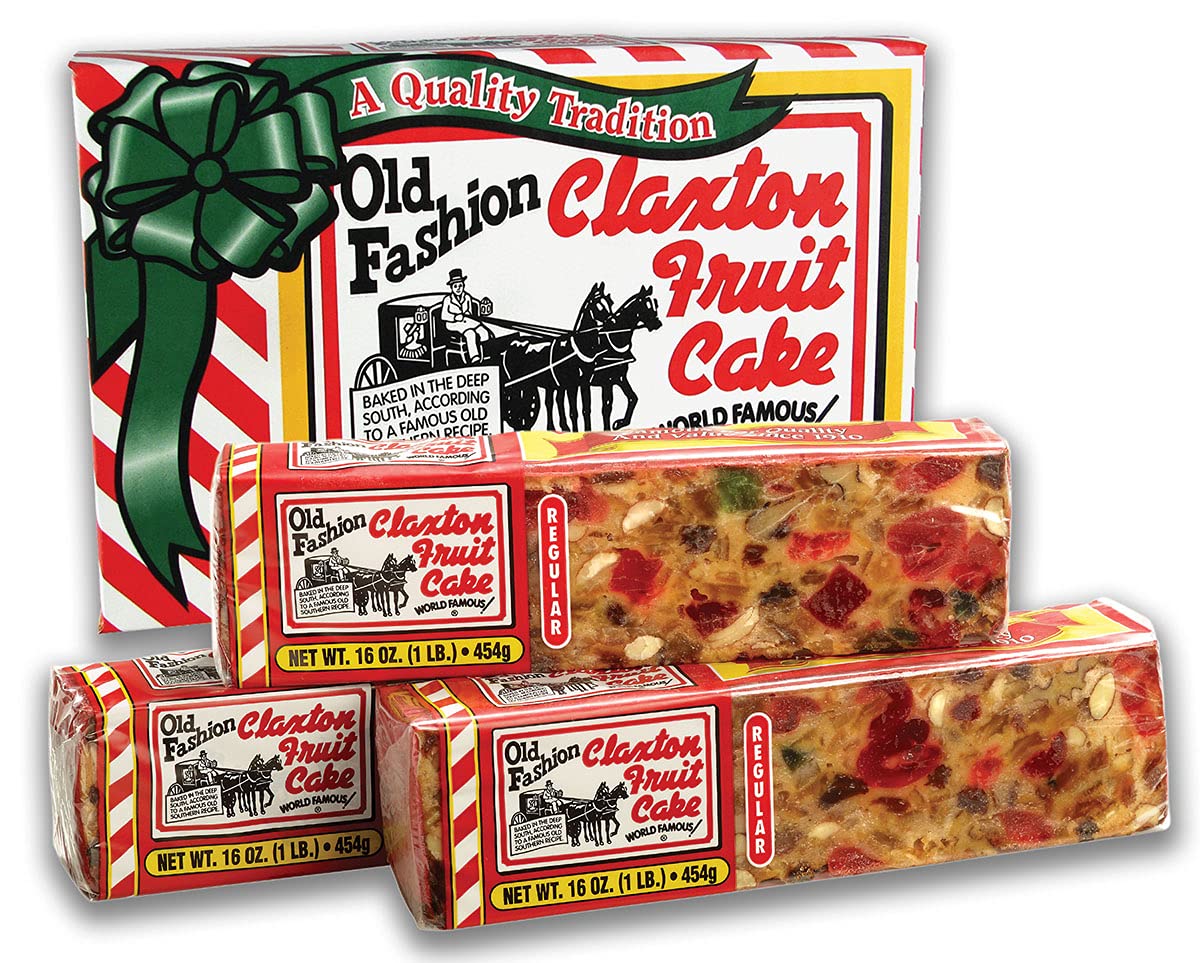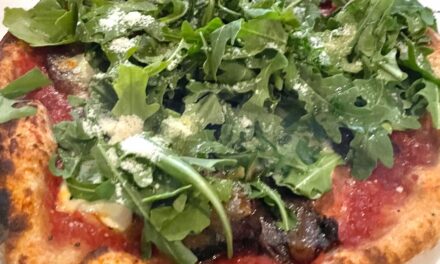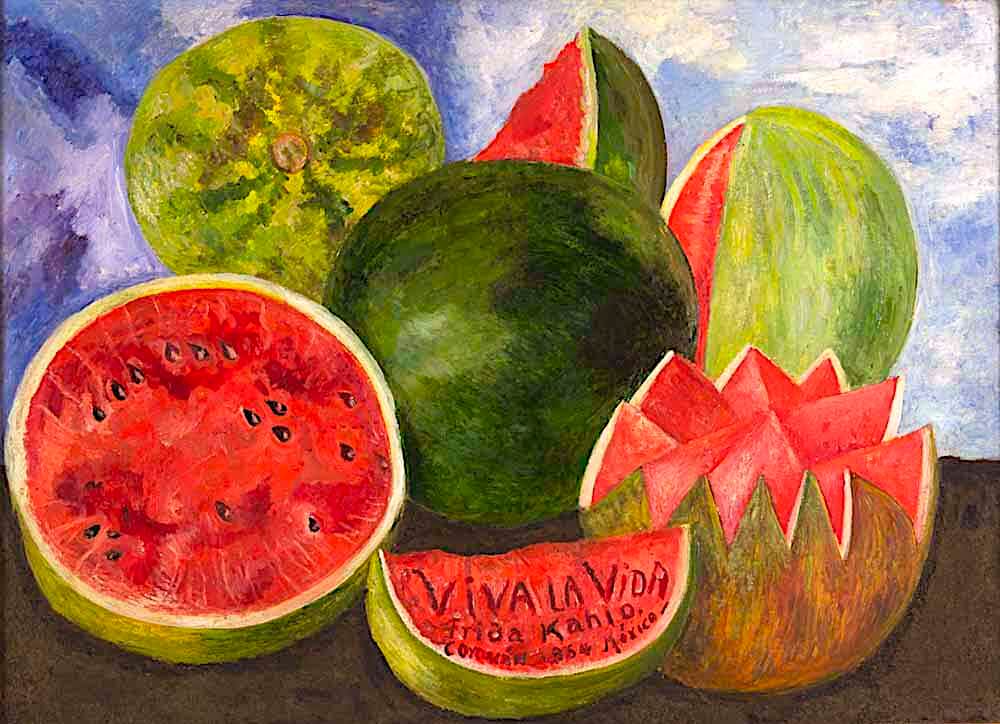Roast Lamb in Mint and Garlic Sauce, photo by Sakkra Paiboon via Flickr CC BY-NC-ND 2.0 DEED
Spring Lamb: for Easter and Beyond
The Ghent Altarpiece is one of the world’s most priceless masterpieces of painting. Created by the Van Eyck brothers for a cathedral in today’s Belgium, the massive polyptych is around 15 feet wide, weighs almost two tonnes, and contains twelve main painting panels and numerous reverse paintings.
The centrepiece of the Ghent Altarpiece is The Adoration of the Mystic Lamb, one of the most peculiar paintings of all time. All of the panels are meticulously rendered, with details so fine as to seem impossible. The image features a sheep, dead centre, under the blazing orb of the sun with a dove in flight inside it. The animal is a fountain, spurting blood into a golden chalice. It is surrounded by lush rolling greens and rosebushes, by praying choirs of angles, and by multitudes thronging towards him in reverence, at least 100 figures intricately depicted and countless more suggested in the crowds.
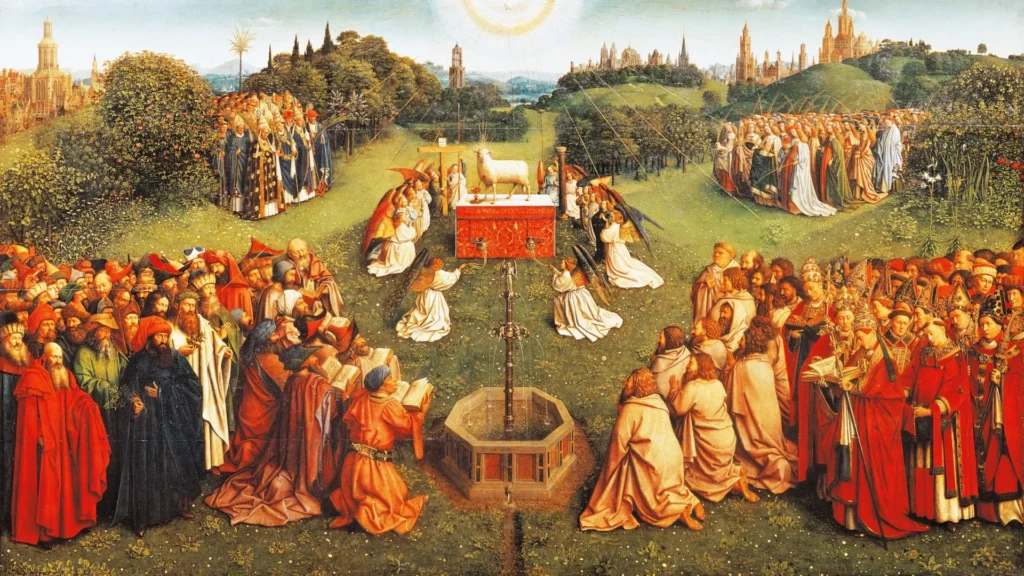
Adoration of the Mystic Lamb, Ghent Altarpiece, by Jan and Hubert Van Eyck (Flanders) 1432
Jan Van Eyck in particular remains well known across almost six centuries for his miraculous powers of draughtsmanship and brushwork. He could seemingly paint whole worlds inside of a couple of millimetres of panel. This kind of quality craftsmanship from a nice German fellow was one thing that caught Hitler’s attention. The mass murderer was planning to erect a kind of “super museum” for art and artifacts that reflected his tastes. But even more importantly for this particular art collector, this painting held secret ciphers that would lead him to the Holy Grail.
Hitler was not concerned, of course, about the age-old symbolism of an innocent Jewish man being killed unjustly. Nor was he interested in being forgiven for his heinous sins. Adolf despised Christianity for ruining the world with tenets of compassion and inclusivity. But he held deep beliefs in occult and metaphysical powers, hidden and corrupted by Jews and Catholics alike. He believed that the Mystic Lamb’s transcendental abilities were available to him, should be hold the magic cup for himself. Van Eyck’s painting surely harboured the hidden codes needed to become God.
You can’t make this stuff up. It sounds mad, and it was. Not exactly the kind of artwork you could secret inside a pocketbook, like a piece of jewelry. The Nazis hid the barn-door sized behemoth in some salt mines in the Alps. Hitler was a sore loser, and had dynamite at the ready to blow the thing to smithereens in the case of defeat. But thanks to the Monuments Men, special allied forces who rescued abducted artworks from the Nazis, it was saved. Art scholar Noah Charney wrote all about it in the riveting true adventure, Stealing the Mystic Lamb: The True Story of the World’s Most Coveted Masterpiece.
A much simpler painting of the mystic lamb is from Spain’s Francisco de Zurbaran. He painted several versions of the same theme- a dead ram on a black background, little legs trussed together. I saw this stark and stunning work when visiting Bogota some years ago. Among the abundant varieties of vivid, colourful, macabre and intense artworks I experienced in Latin America and Spain, it was this plain and small piece that has stuck with me. There are no bloody fountains, no religious embellishments in this version, but the gravitas of the symbolism could not be more piercing. Agnus Dei, the lamb of God. This particular rendering of the lamb for the slaughter was appropriated by a number of artists afterwards, and Zurbaran’s lamb shows up in work by his follower Josefa de Obidos, Willem Zijlstra, and many more.
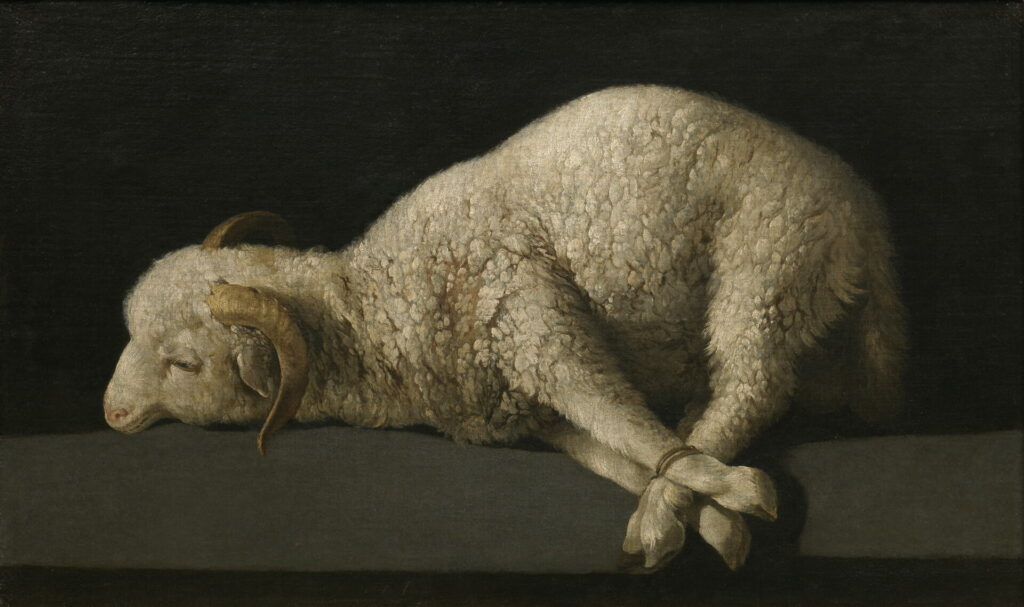
Agnus Dei, by Francisco de Zurbaran (Spain) c. 1630s
In today’s secular culture, it can be difficult to understand what Zurbaran and Van Eyck were trying to say. Our modern sensibilities find the idea of sacrifice primitive and repugnant. The trilogy of Abrahamic faiths take a beating for their mythology surrounding the sacrificial lamb. We recoil at the story of God commanding Abraham to slaughter his precious son to prove his faith. What a barbaric request!
Perhaps it is the outcome of this story that matters most. God substituted a ram at the last moment and saved Isaac. What set the monotheist faiths apart was that Abraham did NOT perform the human sacrifice, a common practice to appease the gods throughout Mesopotamia, and pretty much throughout every continent, too.
In Christian mythology, God turned the tables and offered his child to humankind. The Mystic Lamb became the human bridge, triumphing over pain and death to bring us hope and eternal life.
Lamb is an important holiday feast food for all the people of the book: Muslims, Jews, and Christians. It is central to Jewish Passover meals and breaking the fasting period of Ramadan for Muslims. It is customary to many Islamic cultures to feast on lamb for Eid al-Adha, and to share the feast with those less fortunate.
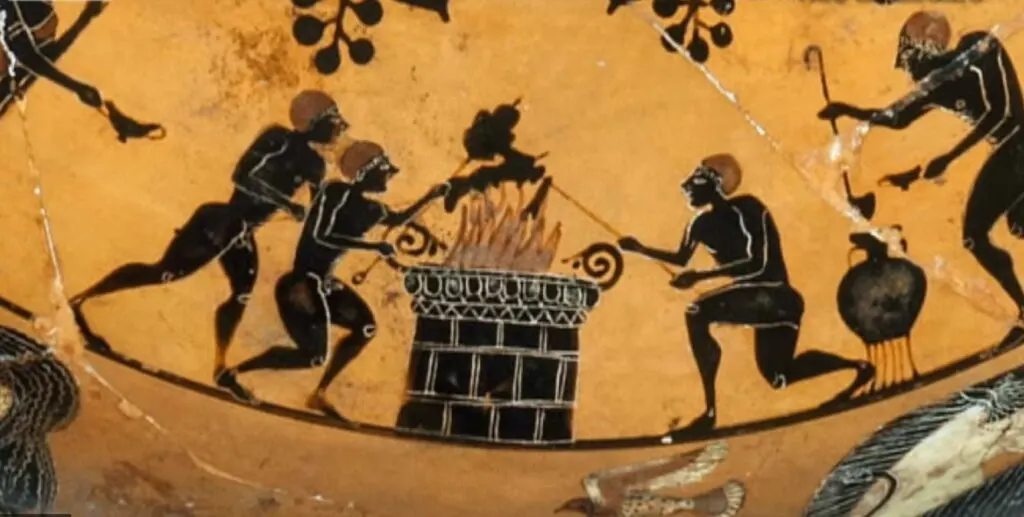
Ancient Greeks Cooking Ovelias Style Lamb.jpg
Lamb is a very traditional Easter food. Even as ham and poultry have become very common, millions of tables around the world will be preparing lamb come late March. Lamb is the fourth most commonly eaten animal in global cuisine. Greek Easter feasting means roasting a whole lamb on a spit to break traditional Lent season fasting. The French have Le Gigot D’Agneau Pascal, or roasted leg of lamb.
While Easter and older religious rites attach profound symbolism to eating lamb for these holidays, of course there are even older associations with renewal and life because of the cycles of the seasons. Before monotheism, spring was celebrated the world over in regional folk religions. The earth coming back to life with all of its promises in blossoms, blooms, and baby animals was marked ritually as well. Imbolc is an ancient Gaelic festival that celebrates the lambing season and “St. Brigid,” who had an earlier incarnation as a goddess. This event has been recently reinstated as a national holiday and heritage event for Ireland.
There are lots of good reasons for sheep’s ongoing popularity. In many regions of the world, there are religious restrictions on pork and on beef. Sheep are not implicated and so they provide meat that can be shared from neighbour to neighbour.
It’s possible that sheep are the oldest domesticated livestock we know of. We’ve had them for about ten thousand years. (Interestingly, dogs were domesticated much earlier, but few cultures commonly eat dog meat.) The mouflon is the ancient wild version, native to the Caspian area of the planet, Turkey, Armenia, Azerbaijan, Georgia and Iran. Other wild sheep may have been domesticated independently in other regions of the world.
The idea of the shepherd is still iconic and archetypal even to those of us quite removed from rural life. Perhaps this is because it is one of our most ancient and essential roles. Even if you grew up in an American city, for example, you likely understand the idea of a “flock of sheep” and can picture a shepherd walking along the hillsides and valleys.
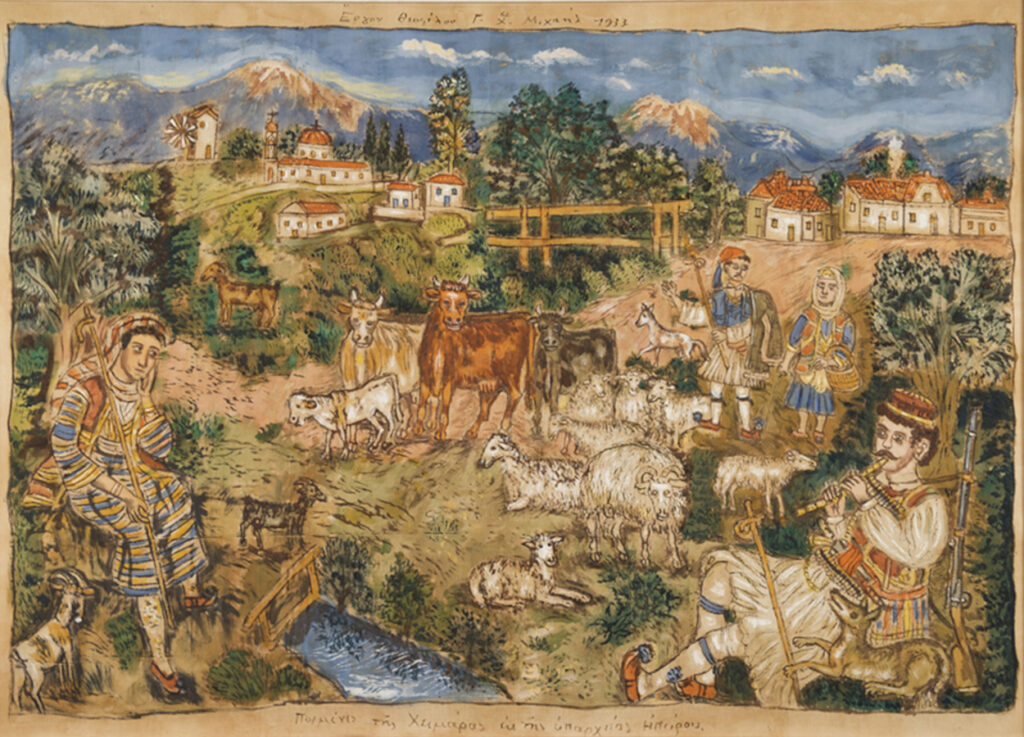
Shepherds of Himara, by Theophilos Hatzimihail (Greece) 1933
Sheep were by nature easier to domesticate and shepherd. Goats, however freaking cute their babies are, are by temperament unruly and destructive. Sheep are famous for following orders and being more docile. The derogatory term “sheeple,” refers to people who are “like sheep” and follow orders without thinking for themselves. On the other hand, we think about sheep in terms of innocent and innocents, which is why the spiritual symbolism in the paintings is so viscerally striking.
Other benefits to us were that sheep were not as violent or sexually aggressive as other wild animals, but still reproduced easily, making them particularly suited to domestication and life alongside humans. Pastoral life was still full of goats, however, but sheep had the very generous gift of warmth in their wool. Sheep could easily survive themselves grazing in wintery lands, but people in colder regions and altitudes depended on them to keep warm. Some theorize that humans ventured into colder climates in the first place because sheep made it possible.
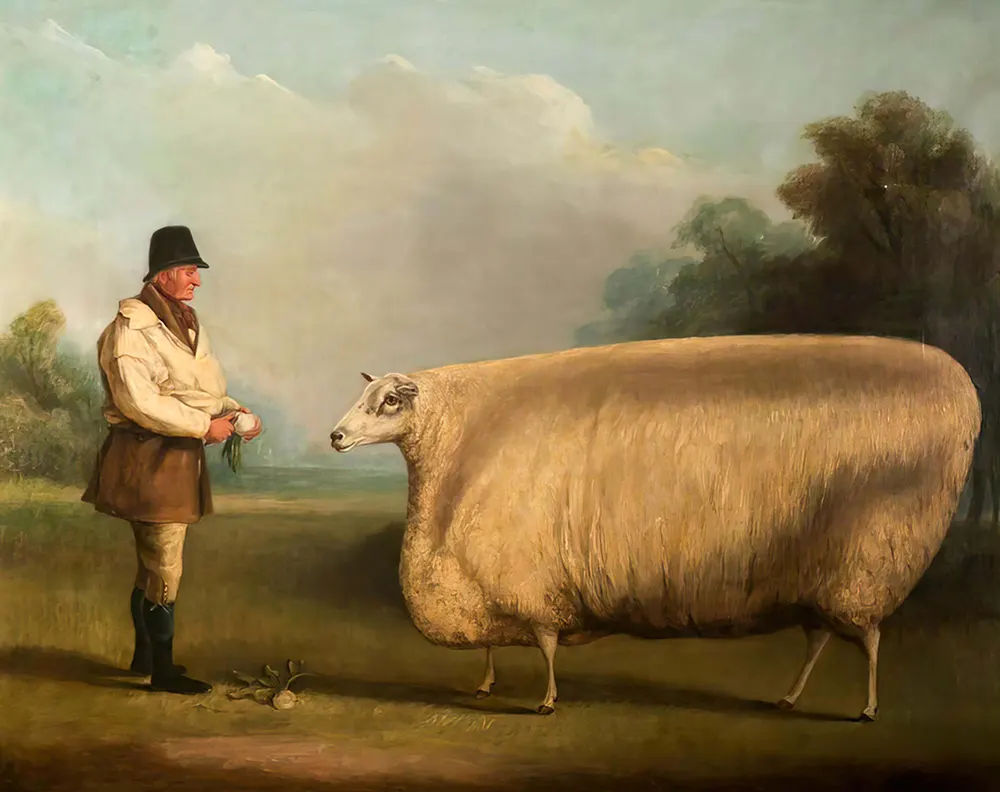
Prize Sheep, by William Henry Davis (UK) 1838
Traditional cultures prized every part of the sheep. Beyond food, the wool is an invaluable resource for warm and beautiful clothing. Even the horns of the ram made musical instruments, the shofar, used in Jewish religious rituals.
Ewe milk is used for dozens of kinds of cheese, including ricotta, feta, and pecorino.
For meat, every part of the mammal is valuable.
Sheep feet, often called “trotters,” are sometimes seen in regional cuisines in Iran, the Maghreb, South Africa, and Scotland.
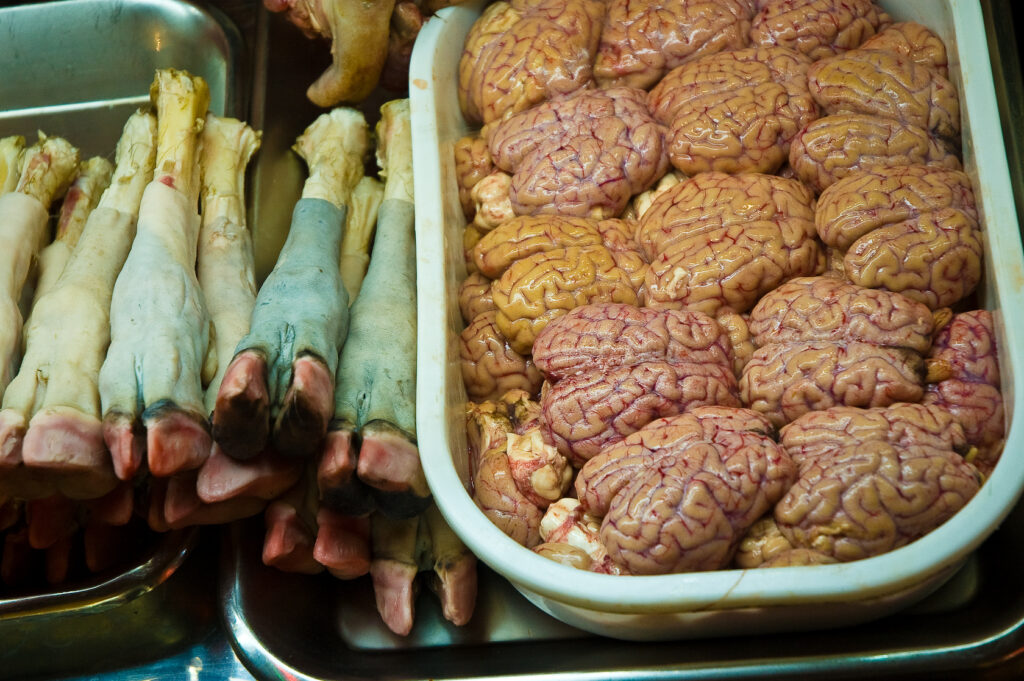
Sheep Brain and Legs at Butcher, photo by Bobulix, via Flickr CC BY-NC-ND 2.0 DEED
Sheep brains are a delicacy in France and some parts of the Middle East. In Morocco, they are famously sold throughout the markets of Marrakesh. Locals know how good they are, but adventurous tourists are rewarded, too. Sheep brains are tender, buttery, perfect for sauces made of turmeric and coriander.
Sheep’s head soup is an ancient tradition. You can pick up sheep heads in North York at the Persian supermarkets. This ultra nourishing part of the animal can be simmered with a variety of herbs or spices, or just plain, for power broth. Ras Koruf soup is a Sudan specialty. The head is also used in Greek, Turkish, Georgian, and other Mediterannean region soups.
The head is not just for boiling. Some areas eat it straight up. Svio is an Icelandic delicacy. The sheep head is singed to remove the hair, cut in half, and boiled without the brains. This was originally for the most poor who couldn’t afford the best meat, but it is widely enjoyed today. The eyes are the favourite part of the head for most Icelanders.
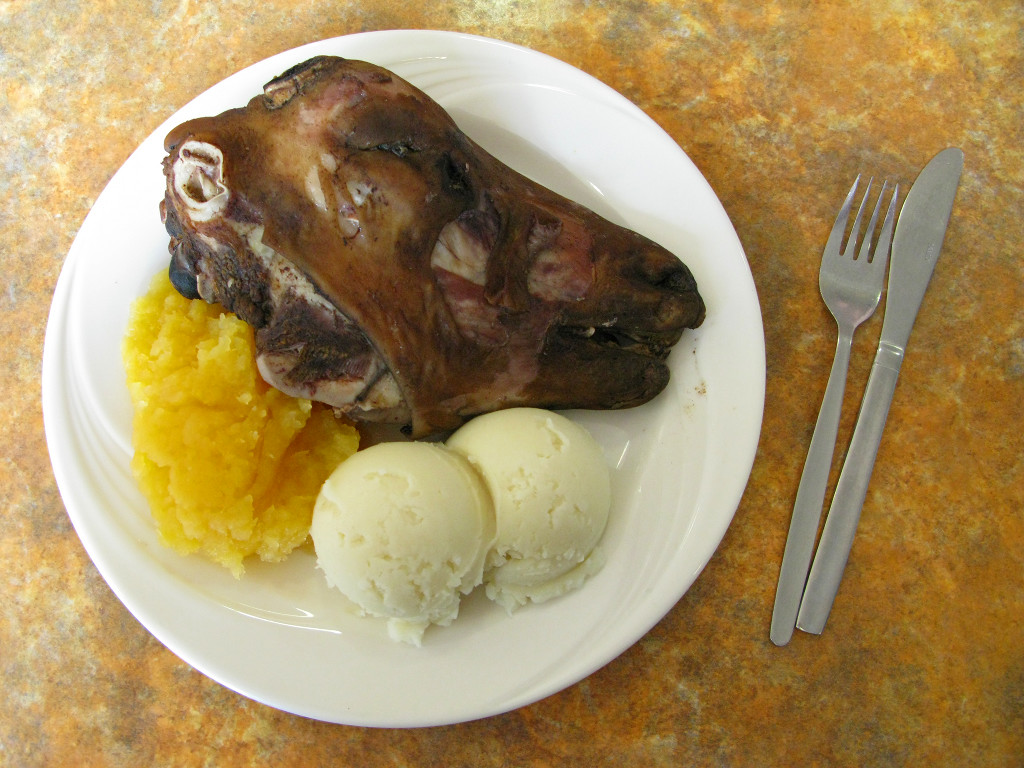
Svið with Mashed Potatoes in Iceland, photo by Schneelocke via Wikimedia Commons CC BY-SA 3.0
Sheep offal is also widely valued for its nourishment and flavour. “Easter Soup” in Greek tradition means magiritsa, made of the lamb organs removed before roasting for the holiday Sunday meal. Scottish haggis is the sheep’s stomach, stuffed with boiled liver, heart and lungs. Lamb liver is eaten raw in Lebanon for breakfast- kasbeh nayeh- along with raw chunks of fat from their tails!
Beware the innocuous sounding dish, “lamb fries.” This delicacy is actually lamb testicles!
Mutton, or older sheep, is gamier and chewier than many of us are used to today, so it is not as popular a purchase in these parts as other beasts. You’ll recall the scene in Seinfeld where Jerry is not impressed by the meat-heavy cooking of his new love interest. When she feeds him mutton, he can’t chew the stuff and spits it out into some napkins when she isn’t looking. The napkins become bait for dangerous dogs who smell the meat in his coat pockets, and hilarity ensues.
But cultures that use herbs, spices and marinades find a way around the tougher texture of adult sheep. Mutton can be tenderized with acidic ingredients like lemon or wine and vinegar. It could be pounded or ground up. In India, mutton masala is widely enjoyed, a kind of curry and tomato stew.
Lamb, of course, is the crème de la crème of sheep meat. Often called “spring lamb” this is the young animal, fresh and tender.
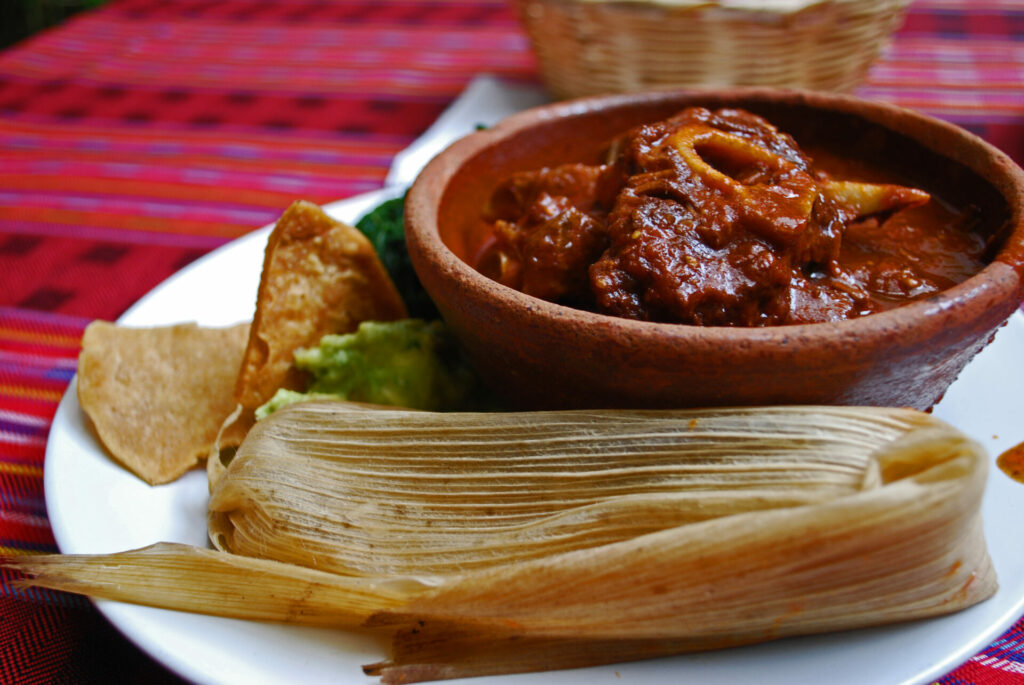
Lamb Stew, Guatamala photo by Kirk K. via Flickr CC BY-NC-ND 2.0 DEED
In Argentina, it’s lamb al asador. This is barbecued and butterflied, slow roasted over an open fire and basted regularly with garlic, chile, rosemary, thyme, and often, beer.
Lagman (among other names) is a pulled noodle and lamb stew from China, Kazakhstan, Kyrgistan, Uzbekistan, and beyond. Hünkar beğendi is a Turkish stew with lamb and pureed eggplant.
Lamb “lollipops” are also ubiquitous as delicious finger food, small lamb chops grilled and dipped into crusts and goos of every marvelous flavour, including minty jellies.
Xinjiang lamb skewers are a popular street food and home-grilled meal for Uyghur Muslims in China, blending Chinese and Arabic flavours and techniques.
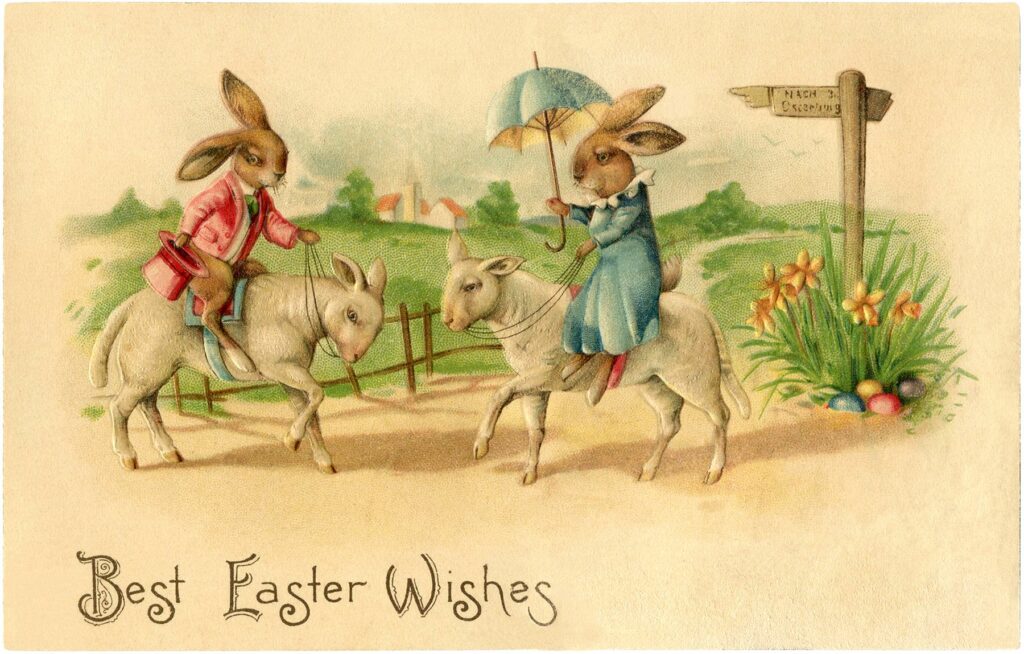
Antique Easter Card
Regardless of one’s personal spiritual or cultural affiliations and associations, it’s hard not to feel the wheel turning from winter into renewed bloom during spring celebrations. When the first crocuses and snowdrops peek out from sleep, and baby beasts start bleating and chirping in the world, most of us feel that sweet relief, an elemental feeling of gratitude for the season’s turning. Lamb is practically synonymous with spring, and brings so many possibilities to life, and to the table.
Lorette C. Luzajic
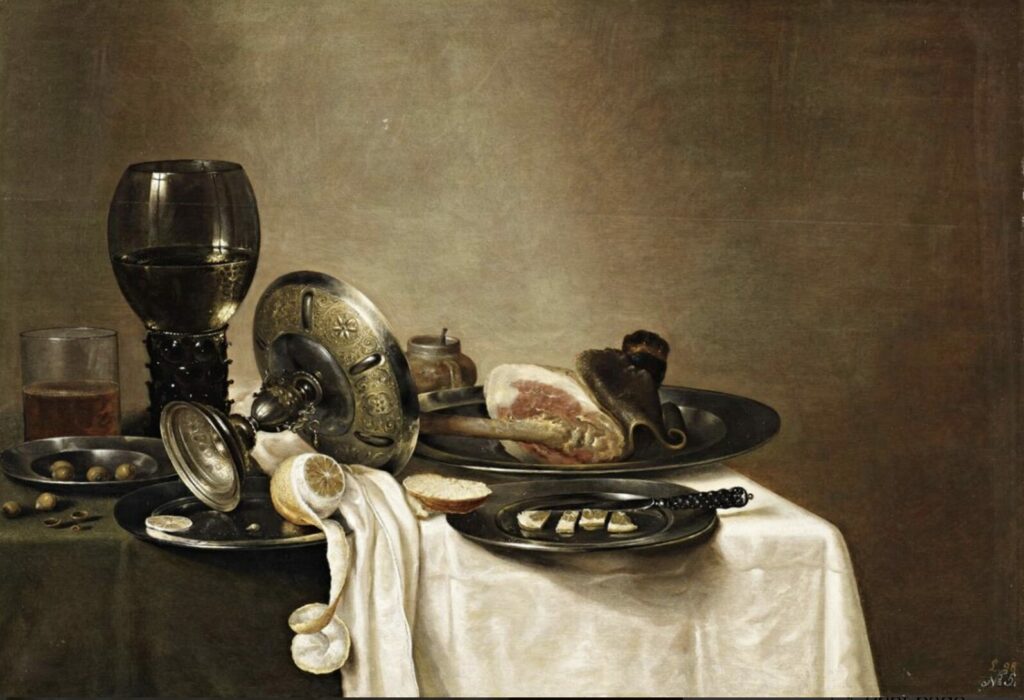
Still Life with a Leg of Lamb, a Peeled Lemon, two Glasses and Pewter Dishes on a Table, by Willem Claesz Heda or His Workshop (Netherlands) 1630s

